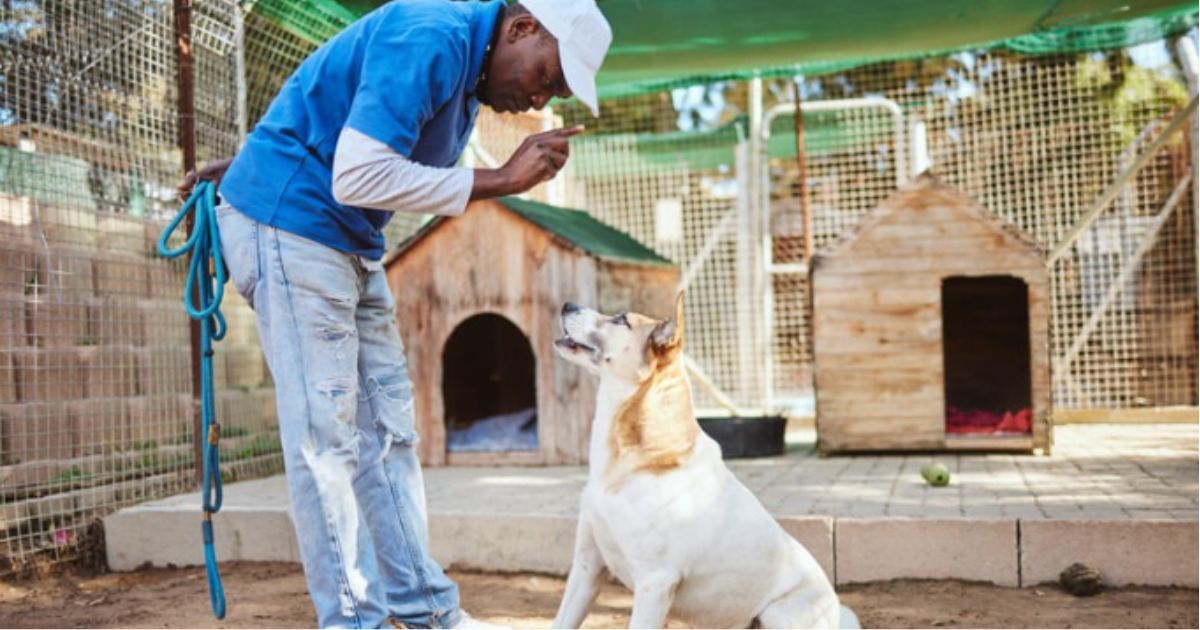How to become a Dog Trainer

Training dogs isn’t just about teaching them to sit or stay and getting the owners to understand that; it’s about learning animal behavior, learning how to communicate with people, and helping dogs succeed at being the best dog they can be while helping the people they live with have great dogs. If you’re a fan of canines, have a bit of patience and a willingness to teach, consider a dog training career. Here’s a roadmap for getting started on your journey as a dog trainer, the training and education required and answers to common questions about the profession.
What Does a Dog Trainer Do?
Dog trainers train dogs and their owners, teach them new commands, and correct undesirable behaviors, while promoting healthy pet-owner relationships. Training can range from simply helping your dog become more obedient, all the way to prepping a dog for specific work — such as search and rescue, dog therapy, or narcotics detection. The job is as much about training people as it is training dogs, as owners have to continue the training at home for the results to last.
How to Become a Dog Trainer
1. Understand Dog Behavior and Training Techniques
Begin to familiarize yourself with dog behavior. Read books, watch videos, go to seminars, or take beginning level classes on animal behavior and training. Knowing why dogs behave as they do-and how they learn the way they learn-is the key to training.
Now that you have a dog, work on basic obedience and experiment with training techniques. Having experience living and working with dogs will teach you that “training” is not merely a function of the dogs themselves, but also can be dependent on an owner’s training.
2. Gain Practical Experience
Training your own dog is a beginning, but experience- with many dogs- is necessary. Spend some time volunteering at your local animal shelter, rescue, or dog daycare to experience handling a variety of breeds, ages, and temperaments. You might also be able to ask friends or family if you can practice training on their dogs.
Another great way to learn is to apprentice with a well-established dog trainer. Apprenticeship durations can range anywhere from several months to a year, gaining valuable experience in the field under the supervision of a professional.
3. Think About Going to School or Getting Certified
You don’t need a formal degree to become a dog trainer, but a certification can increase your credibility and job opportunities. Firm Certifications There are plenty of well-established organizations that offer dog training certifications, including:
- The following organizations are accepted as a 3rd party for determination as to whether or not the organization should be approved by the CCPDT.
- International Association of Canine Professionals Professional Alliance for Canine Educators (PACE)
- National Association of Dog Obedience Instructors (NADOI)
A high school diploma or equivalent, hands-on experience, and passing one or more written or practical exams are standard requirements to enter a certification program. For example, the CCPDT demands at least 300 hours of dogs training within the past three years and the successful completion of a 180-question exam.
4. Join Professional Associations The post Join Proffessional Associations appeared first on igonest.
Joining forces with organizations, such as the Association of Professional Dog Trainers (APDT), demonstrate to clients this isn’t just another gig on the side. Membership also includes continuing education, networking, and listing in trainer directories.
5. Choose Your Specialization
As you gain experience focus on:
- Basic obedience
- Behavioral modification
- Agility or competitive training
- Service or support dog training
- Puppy socialization
Dedicating yourself to a niche can differentiate you and boost your earning potential.
6. Grow Your Business and Name
If you want to be on your own, develop a business plan, get your services up and running, and market yourself. Create a website, establish rapport with local veterinarians and pet professionals, and request referrals and customer feedback from happy purchasers.
If you like working, look for longer term placements with established training organisations, kennels or rescues. Feature your experience, certification and any additional unique skills on your resume and cover letter.
7. Never Stop Learning
The science of dog training is also constantly changing. Keep up to date by going to workshops, reading the latest research, finding out about new training methods. C.E. isn’t just to help you get better at what you’re doing, it’s also to communicate to your clients that you care.

How to become a Dog Trainer
The Other End of the Leash: Why We Do What We Do Around Dogs
Patience: Dogs (and humans) learn at different rates. Patience is key to success.
Communication: It is as essential to communicate well with owners as to work with dogs.
Observation: Knowing how to interpret the body language of a dog and to understand the finer points of canine behavior is critical to prevent ineffective or unsafe training.
Problem-solving: No two dogs are the same. Innovative interventions are used to tackle individual behavior to support specific needs.
Empathy: Knowledge of the viewpoint of the dog and the owner, thereby developing trust and a relationship.
Frequently Asked Questions
1. Do I need to have a degree to become a dog trainer?
No degree is required, although certifications from respected fitness organizations can help with credibility and job prospects.
2. How many years does it take to be a dog trainer?
The timeline varies. How long it takes to gain work experience and get certified could range from several months to a little more than a year, depending on your prior experience and the program you sign up for.
3. What is the cost of certification?
Prices vary from a few hundred to several thousand dollars depending on the programme and level of certification.
4. Can I continue working while getting certified?
Yes. Many certification programs have flexible schedules so you can continue working or volunteering throughout the duration of your training.
5. How much does a dog trainer typically make?
Pay depends on where you work, what you do and how much experience you have. For example, in the UK the average annual salary is £23,000 or higher if you specialise or own your business.
6. What environments do dog trainers work for?
Dog trainers can operate as independent contractors, or for training companies, kennels, shelters or police departments. Some go to client’s homes, while others teach at their own space.
7. Are you mad that you are a dog trainer?
If you love dogs and love people and you want to help the world be a better place by helping people and their dogs live more harmoniously together then being a dog trainer might be the career for you.
8. Do online dog training classes work?
It can be a complement — you need classroom work if you want to get the academic piece of it, but you need hands-on as well. Check for formats that include a blend of available online study and hands-on learning experiences.
Final Thoughts
A dog trainer career, like any profession, is a professional journey that demands a genuine commitment to lifelong learning and that comes with highs and lows. Through study, hands-on experience, certification, and a little luck, you too can forge a career helping dogs and their owners enjoy life to the fullest together.
If you’re eager to get started, learn as much as you can about dog behavior; look for hands-on experience; network with professionals. If you are passionate and love dogs…our dog training world awaits you!







